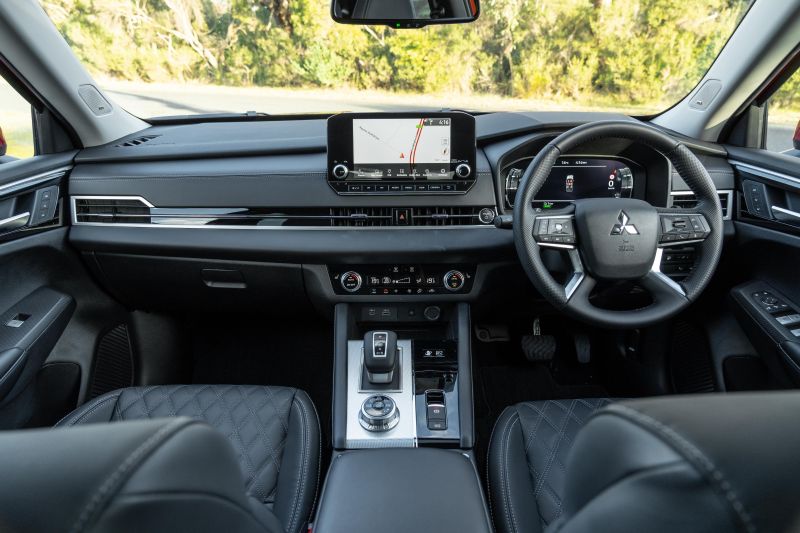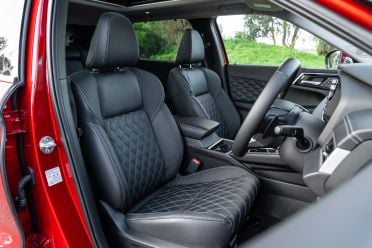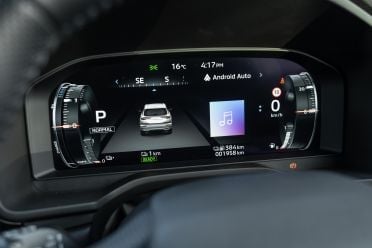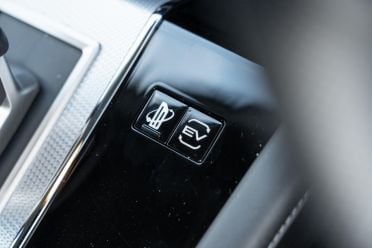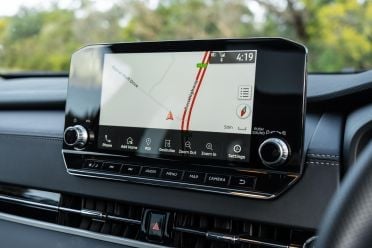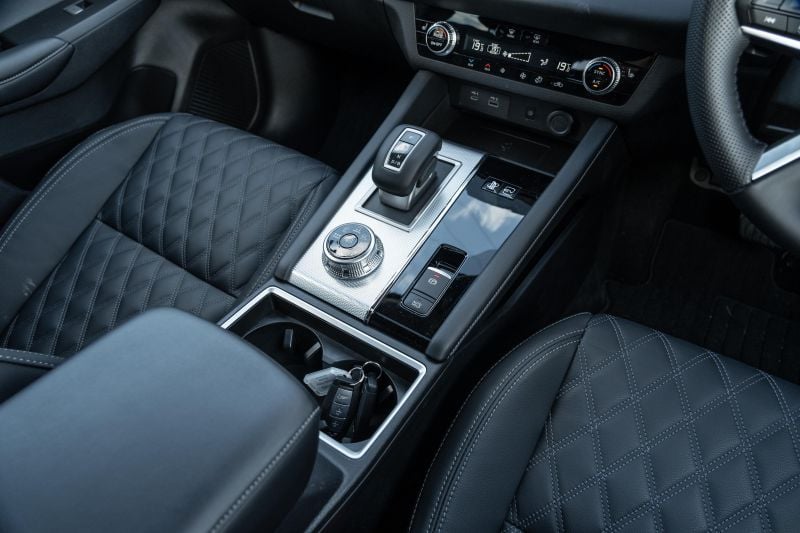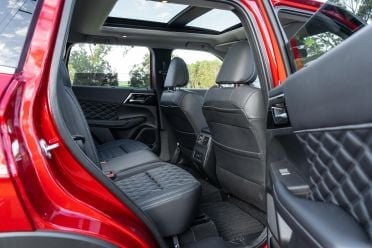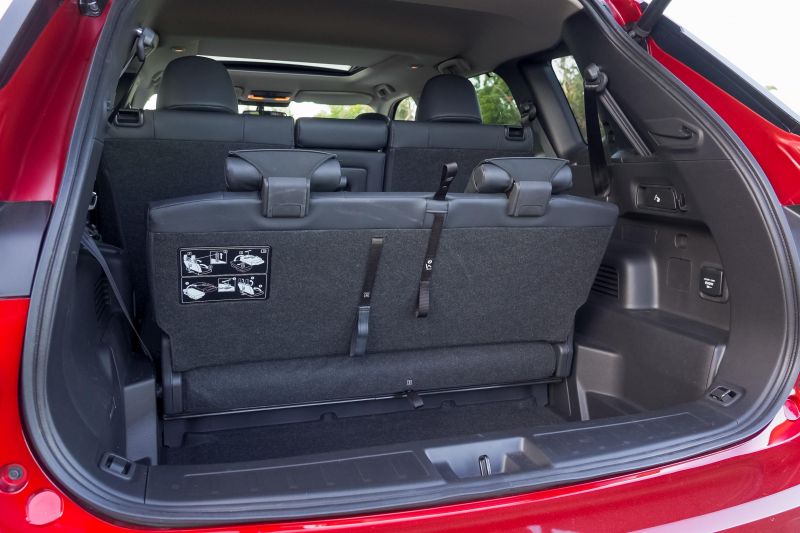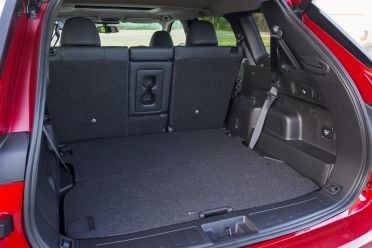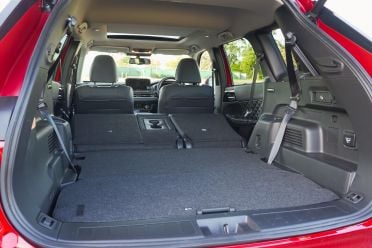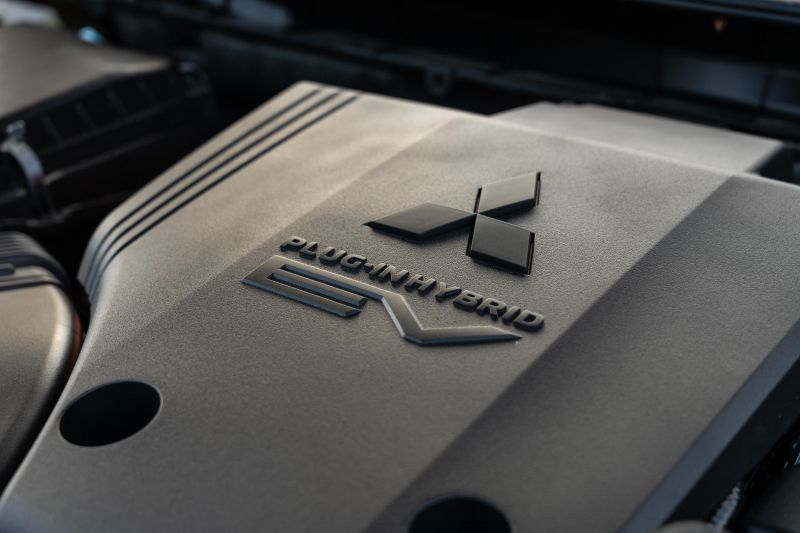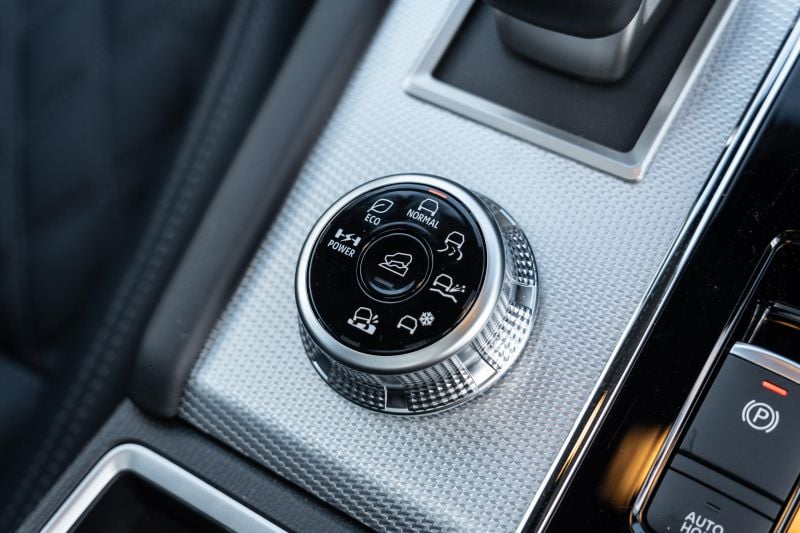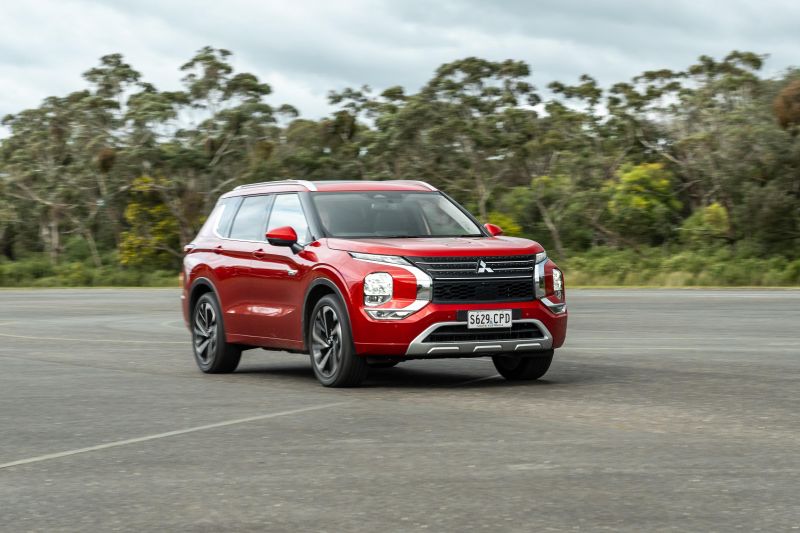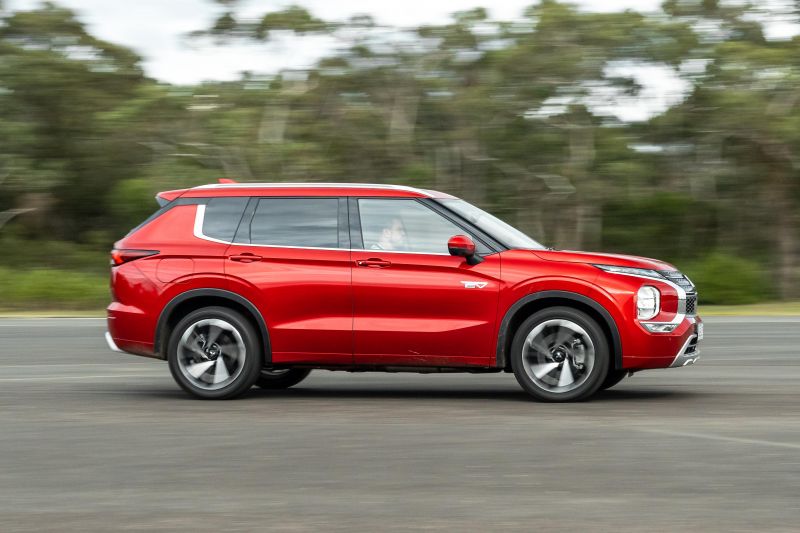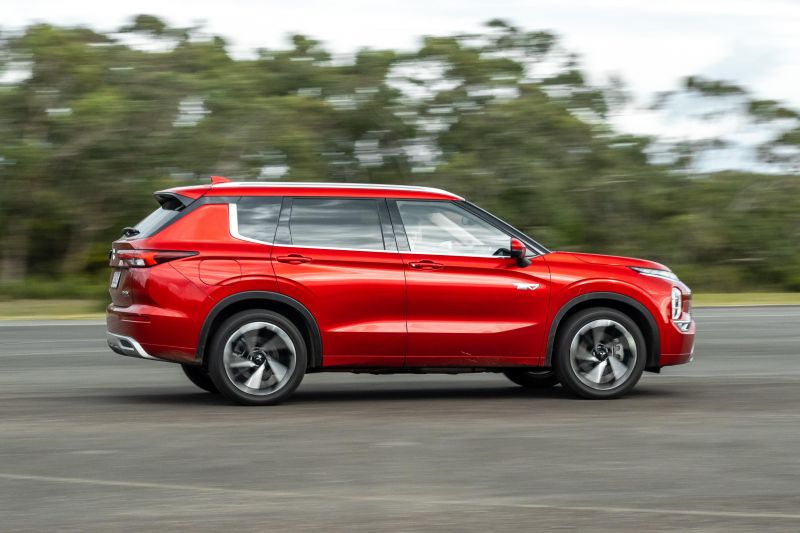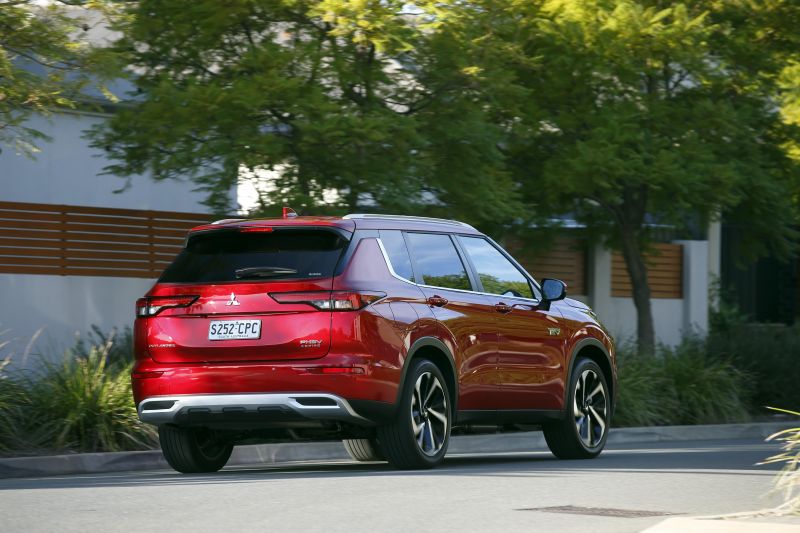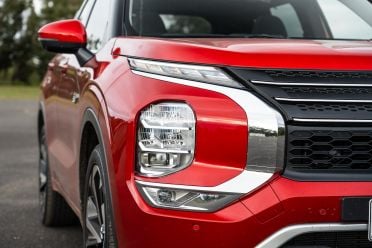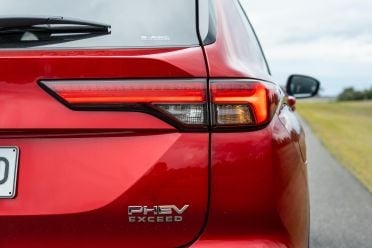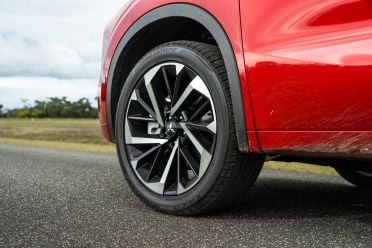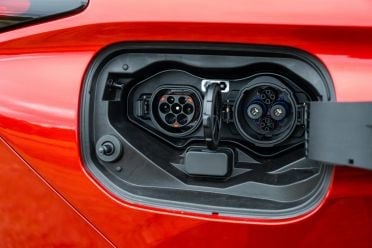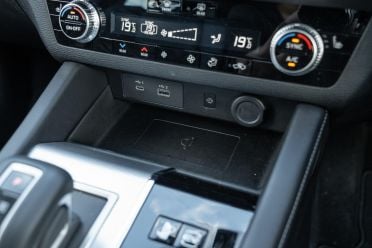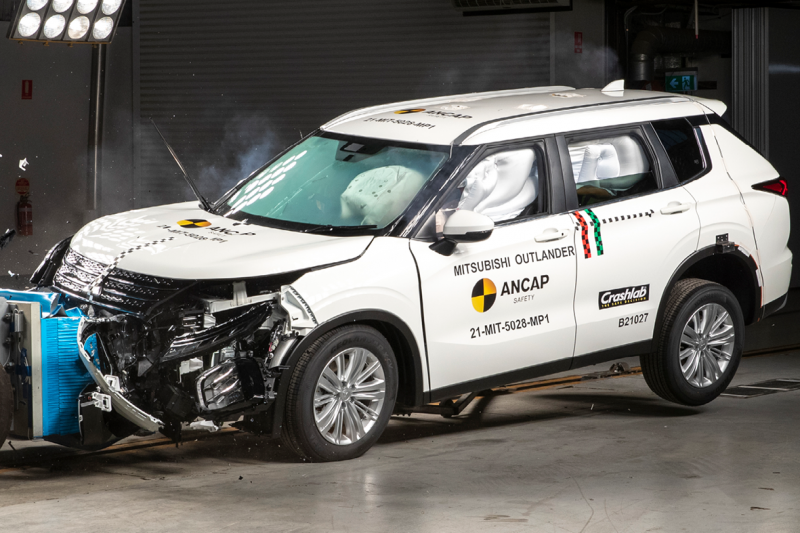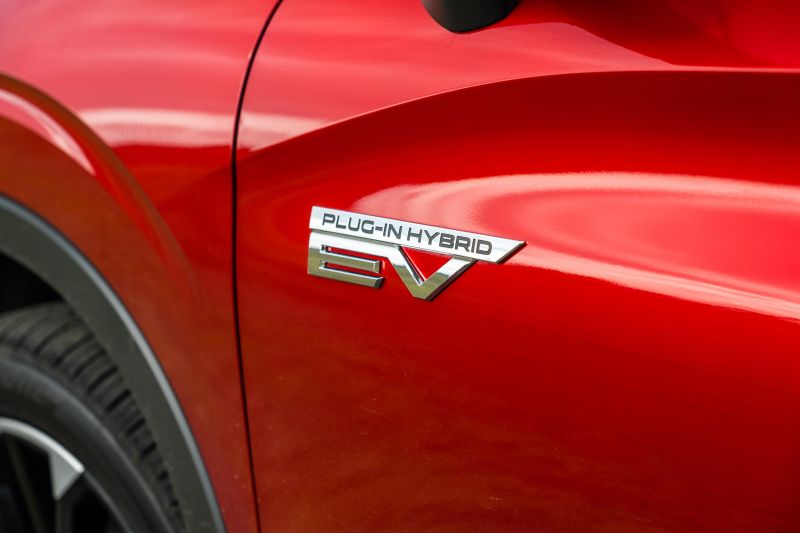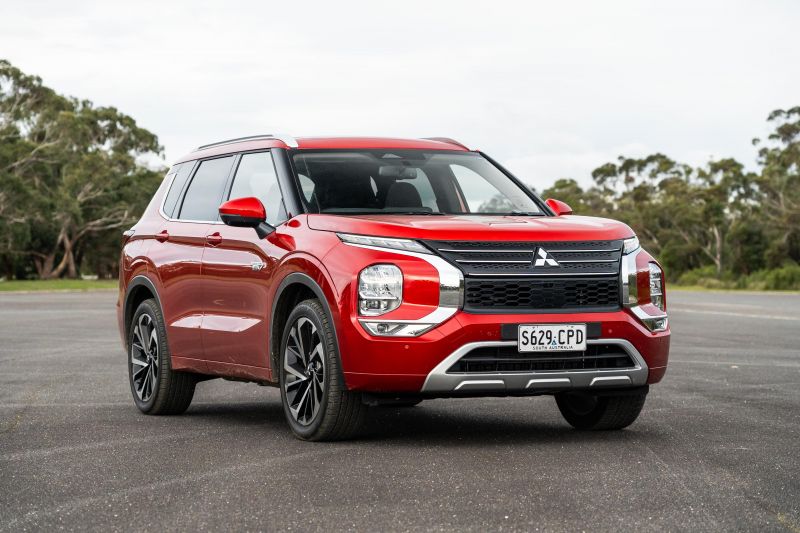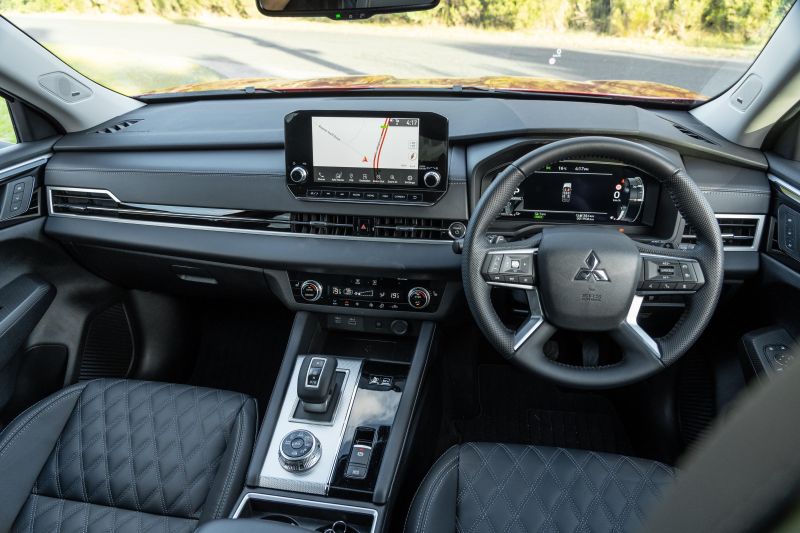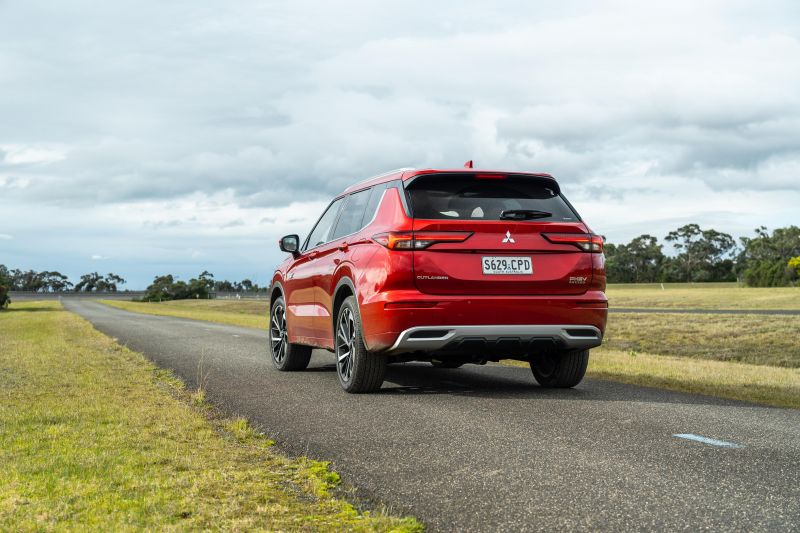The latest generation of Mitsubishi Outlander Plug-in Hybrid (PHEV) has finally landed in Australia with a much steeper asking price, but it brings with it class-leading plug-in hybrid capability and a significantly larger battery for extra driving range.
Mitsubishi has long been a leader in PHEV development, and it’s hoping this latest generation of Outlander PHEV strikes the right chord with Mitsubishi’s loyal fan base.
Unlike some launches, we had the chance to test the Outlander PHEV in and around Adelaide and the surrounding hills, followed by a 700km drive from Adelaide to Melbourne and then a full day at our proving ground test track.
So how does it stack up?

How much does the Mitsubishi Outlander Plug-in Hybrid cost?
The Mitsubishi Outlander PHEV range kicks off from $54,590 plus on-road costs for the entry-level ES. That’s a hefty $17,000+ jump over the equivalent non-PHEV version.
The model we extensively tested was the $65,990 (plus on-roads) Exceed variant with 5+2 seating.
2022 Mitsubishi Outlander Plug-in Hybrid pricing:
- Mitsubishi Outlander Plug-in Hybrid EV ES 5 seat: $54,590
- Mitsubishi Outlander Plug-in Hybrid EV Aspire 5 seat: $60,990
- Mitsubishi Outlander Plug-in Hybrid EV Exceed 5+2 seat: $65,990
- Mitsubishi Outlander Plug-in Hybrid EV Exceed Tourer 5+2 seat: $68,490
Prices exclude on-road costs
What is the Mitsubishi Outlander Plug-in Hybrid like on the inside?
Often people are surprised when I tell them the Outlander shares a platform with the new Nissan X-Trail. From the outside both look totally different from one another, and even when you delve deeper there are only minor similarities that you notice.
Mitsubishi wanted to add its own flair to the Outlander inside the cabin, and achieved that with a more premium and upscale set of materials across the dashboard, centre tunnel and door surrounds. Extensive use of piano black material dulls the experience somewhat, but for the most part the presentation is on point.
Ahead of the driver is a large 12.3-inch display and central to the cabin is a smaller 9.0-inch colour infotainment system that comes with wireless Apple CarPlay and Android Auto.
It teams with a Bose branded nine-speaker sound system and a head-up display. The sound system is good, but surprisingly not that amazing. It needs a stack more bass and doesn’t dazzle as much as a BOSE branded sound system should.
Outside of that the infotainment system is on point, while the driver display is high resolution and provides a detailed functional overview of what the car is doing.
Storage is good as well, and you’ll find wireless phone charging to keep things moving while you run wireless smartphone mirroring.
Given I had the chance to spend so much time in the car I appreciated the supportive and comfortable seats. They hug you in nicely and offer electric adjustment for both the driver and front passenger. Stepping up from the Exceed to Exceed Tourer also brings a massage function – not a bad idea for long distance drives!
Mitsubishi boasts a number of EV functions on the Outlander PHEV that make it unique to the segment. Inside the cabin you’ll find two 1500W AC outlets for running things like laptop chargers, small coffee machines and other portable devices.
Hidden within the charge port cover is a Type 2 AC port that offers single direction charging of the vehicle at up to 3.6kW single-phase. Directly next to that is a DC fast charging CHAdeMO port that delivers up to 38W into the battery system.
This Japanese standard port also allows V2G and V2H functionality.
V2G stands for Vehicle to Grid and allows the vehicle to supply energy to the grid at a constant rate up to 10kW. V2H on the other hand stands for Vehicle to Home and allows the vehicle to supply up to 10kW of energy at variable rates to run a home.
What’s the point in this tech? In some countries with unstable electricity supplies, or countries that are subject to natural disasters that affect power supplies, you can use your vehicle to run the home during emergencies or to supply energy to the grid.
The second row is roomy enough with an ability to slide the second row forwards and backwards to supply more room to the cargo area or for the plus two seating in the third row.
The new battery back sits beneath the floor with the location of the inverter also moved to beneath the second row to now allow the Outlander PHEV to offer a third row (which the previous generation wasn’t able to accommodate).
The third row is a kid-only zone. In fact, when the second row is slid backwards all the way there is no gap between the base of the third row and the back of the second row.
So the only way to fit anybody (including kids) in the third row is to slide the second row forward, which eliminates almost all knee room.
Mitsubishi doesn’t claim it’s a space for adults, but we don’t really understand how you’d fit kids into the third row and anybody in the second row at the same time.
Outside of that there’s 163 litres of cargo space available behind the third row when it’s erect.
Dropping the third row increases space to 478 litres to the top of the second row, while dropping the second row increases the load space to 1473 litres.
There’s no spare tyre, instead you’ll find a tyre repair kit located beneath the cargo floor.
What’s under the bonnet?
The Outlander PHEV combines an Atkinson cycle 98kW 2.4-litre four-cylinder petrol engine with a 20.0kWh lithium-ion battery pack and twin electric motors, providing all-wheel drive.
The two electric motors produce 85kW and 100kW (up from 60kW and 70kW in the old car). Total system outputs are 185kW of power and 450Nm of torque.
The new PHEV features a larger 20kWh battery, up from the old car’s 13.8kWh battery, as well as a new battery cooling system and more powerful electric motors.
The Outlander PHEV has a claimed 84km of pure electric driving range and fuel consumption of 1.5L/100km, both on the more lenient NEDC cycle. DC charging is supported via the car’s CHAdeMO port. It has a 56L fuel tank, up from 45L in the old car.
Mitsubishi says it’ll take 38 minutes to charge from 0 to 80 per cent on a DC charger.
One of the reasons Mitsubishi claims to persist with a CHAdeMO port is because it’s the only charge port that allows V2X capability. A number of public fast charging stations in Australia offer high-speed charging through CHAdeMO plugs.
How does the Mitsubishi Outlander Plug-in Hybrid drive?
Unlike some electric vehicles on the market that shock with whacky designs, the philosophy with the Outlander PHEV as a plug-in hybrid is to look and feel just like a regular Outlander.
On the outside you’ll find a set of additional badges and a charging port on the right side of the car, but outside of that it’s all very much like any other Outlander on the road.
The next bit is a little technical, but I think it’s important to explain how the Outlander PHEV works from a technical sense to better understand why it does the things that it does.
It uses both an internal combustion engine (a naturally aspirated 2.4-litre petrol four-cylinder) and a pair of electric motors to move the vehicle. Depending on speed and load it can then vary how these systems interact.
A single speed transaxle located on the front axle features a single fixed gear for the differential drive and another single gear for the generator drive. Depending on wheel speed, the system acts either as a series hybrid or a parallel hybrid.
The battery system is charged using AC or DC through the charge ports, or is charged using the internal combustion engine via a generator.
This is supported by a set of two EV drive modes called Save and Charger, that allow the internal combustion engine to run and use its 98kW capacity to drive a generator, which in turn charges the battery or holds its level of charge for future use.
When acting as a parallel hybrid (speeds above around 70km/h) the internal combustion engine can directly drive the front wheels when engine and wheel speeds match while also running the generator to supply energy to the battery system.
Mitsubishi claims that at speeds below around 70km/h it’s more efficient to run the vehicle via its electric motors, whereas speeds above 70km/h are more conducive to being run directly by the internal combustion engine.
The battery system then also never totally depletes during regular driving. When the driver sees the battery status as empty on the instrument cluster, it still retains around 20 per cent capacity for electric assistance during full throttle applications.
When the battery is at this 20 per cent ’empty’ state, it will constantly switch between electric propulsion and running the internal combustion engine to keep capacity. It’s an important charge state because the small capacity internal combustion engine would struggle to move the car on its own with any great pace if the battery was truly to be totally empty.
Another curious element of the system is that at any speed, the internal combustion engine can also use the generator as a voltage booster for the electric drive system. This allows the system to draw more current from the battery system to achieve peak electric motor output.
That’s why you’ll hear the engine flare up under full throttle – even when you’re driving in the pure EV mode.
So, enough of the technical stuff. How does it actually feel behind the wheel? When you set off there’s no noise. The electric drivetrain is silent and it moves along fuss free. If the battery is full it will always try and use this first before accessing the internal combustion engine.
That means you could in theory drive to and from work daily with a regular charge and then not touch the internal combustion engine.
In the EV drive mode the Outlander PHEV allows a generous amount of throttle input before commanding a voltage boost from the internal combustion engine. It’s in contrast to some EVs on the market like the Kia Sorento PHEV that will rush to switch the internal combustion engine on frequently when too much torque is requested by the driver.
Our first drive stint had us driving around the Adelaide CBD in full electric mode and it was more than sufficient to keep up with traffic and zip in and out of traffic. Our average efficiency in and around the city was around 25kWh/100km.
Mitsubishi has also created a ‘single-pedal’ drive mode that’s meant to mimic Nissan’s e-Pedal. In theory it uses a combination of energy regen and mechanical brakes to slow the car. Where the Nissan e-Pedal system will bring the car to a stop, Mitsubishi’s system stops working from 20km/h and requires the driver to take over.
On the open road the Outlander can maintain its electric drive mode at highway driving speeds, which means the interior remains fairly silent. Even when the internal combustion engine switches on, it remains remarkably silent even when it’s operating at full tilt.
It’s a nice setup that again separates the Outlander PHEV from its competitors, which can be thrashy and noisy when they command the internal combustion engine to switch on for additional assistance.
Inevitably on my long drive I ran the battery dry, which required the internal combustion engine to kick on. Mitsubishi’s combined fuel economy claim relies on a preset test cycle that mimics a number of variables a driver is unlikely to ever meet.
So for the benefit of simplicity if the battery does run dry and you operate the Outlander PHEV as a hybrid, the combined city and highway driving claim is 6.7L/100km.
One of the biggest downsides of a plug-in hybrid is that for longer distance drives once the battery does run dry, you are then lugging around 20kWh worth of battery that’s effectively doing nothing but adding extra weight.
With that said, a fuel economy of under 7L/100km isn’t terrible. My drive from Adelaide to Melbourne netted exactly 6.7L/100km too, which is right on the money.
One thing I noticed on my longer drive, especially during overtaking was that the single-speed transmission works well with the internal combustion engine up until around 100km/h, but after that it really falls off a cliff.
The internal combustion engine reaches its power and torque peak at around 4500rpm and when you’ve exceeded that band it’s all up to the electric motors to keep everything moving.
Not an issue for day-to-day driving, but something I noticed when overtaking. I needed a decent run up to pass longer vehicles and that was just with me on board. Load the vehicle with passengers and luggage and it’ll be amplified further.
There are a number of drive modes available that vary the vehicle’s traction control systems in light off-road situations (you can see how the non-PHEV Outlander performed off-road during our mid-size SUV comparison), but the two I was interested in were Tarmac and Hi-Power.
These two modes operate in ‘full attack’ mode with the internal combustion engine running for maximum power. Through years of rally learnings, Mitsubishi has integrated its active wheel control system that can brake individual wheels to allow the car to turn in better.
When driven at higher speeds on our test track you could feel the system working under you to tuck the front end in out of corners. It’s a great setup and when the Outlander PHEV is in full swing under that 100km/h torque killing marker, it’s really engaging and fun to drive.
Steering feel is good and it’s fun to throw around, which is something I definitely wasn’t expecting from the plug-in hybrid version of the Outlander.
Despite sitting on 20-inch alloy wheels, the ride was compliant in and around the city and felt like it was far more settled and happy with extra weight on board compared to the equivalent non-PHEV version of the Exceed.
Road noise is good, but not amazing. There is a degree of tyre noise that comes into the cabin, which is disappointing given how quiet the engine and driveline package is.
What do you get?
Outlander Plug-in Hybrid ES highlights
- 18-inch alloy wheels
- LED headlights and daytime running lights
- 9.0-inch touchscreen infotainment system
- Wireless Apple CarPlay
- Wired Android Auto
- DAB+ digital radio
- Six-speaker sound system
- 12.3-inch digital instrument cluster
- Keyless start
- Dual-zone climate control with rear air vents
- Cloth upholstery
- Urethane steering wheel
- 40:20:40 split fold and reclining second-row seat
- Hill descent control
- Terrain control
- Trailer stability assist
- Mode 2 and Mode 3 charging cables
Outlander Plug-in Hybrid Aspire adds:
- 20-inch two-tone alloy wheels
- Privacy glass
- ‘High-grade’ LED headlights with auto-levelling
- Power-folding exterior mirrors
- Automatic headlights
- Adaptive high-beam
- LED fog lights
- Rain-sensing wipers
- Silver roof rails
- Silver skid plate garnishes front and rear
- Leather-wrapped steering wheel
- ‘Combination’ seat trim
- Power driver’s seat
- Heated front seats
- 10.8-inch head-up display
- Wireless phone charging
- Keyless entry
- Hands-free power tailgate
- Roll-type tonneau cover
- 2 x USB outlets in rear console
- Electro-chromatic rear-view mirror
- Tyre repair kit
The Aspire also gains an AC power supply for the Vehicle to Load function, with two 1500W, 240V three-pin outlets.
Outlander Plug-in Hybrid Exceed adds:
- Colour-coded lower body accents
- Gloss black B- and C-pillars
- Panoramic sunroof
- 9-speaker Bose sound system
- Third row of seating
- Quilted leather upholstery (Black or Light Grey)
- Power passenger seat
- Two-position driver and passenger memory
- Pull-up second-row sunshades
- Tri-zone climate control with rear A/C panel
- Front door trim illumination
- Aluminium gearshift trim panel
- Power-folding mirrors with memory and reverse auto-tilt
Outlander Plug-in Hybrid Exceed Tourer adds:
- Two-tone body colour
- Two-tone leather upholstery (black and saddle tan)
- Massaging front seats
Is the Mitsubishi Outlander Plug-in Hybrid safe?
The Mitsubishi Outlander PHEV, like the petrol-powered model, has a five-star ANCAP safety rating.
It received scores of 83 per cent for adult occupant protection, 92 per cent for child occupant protection, 81 per cent for vulnerable road user protection, and 83 per cent for safety assist.
Standard safety equipment includes:
- Autonomous emergency braking (AEB)
- Pedestrian detection (day, night)
- Cyclist detection (day)
- Blind-spot monitoring
- Lane departure warning
- Lane-keep assist
- Traffic sign recognition
- Driver attention monitoring
- Emergency Lane Keeping
- incl. oncoming and overtaking traffic recognition
- Predictive Forward Collision Mitigation
- Haptic vibration alert for steering wheel
- Adaptive cruise control
- Front and rear parking sensors
- Reversing camera
Outlander Aspire adds:
- Reverse AEB
- Rear cross-traffic alert
- Surround-view cameras
How much does the Mitsubishi Outlander Plug-in Hybrid cost to run?
The Outlander PHEV is covered by a five-year, 100,000km warranty, though this is increased to 10 years/200,000km if you service within the Mitsubishi dealership network.
The hybrid battery is covered by an eight-year, 160,000km warranty.
Mitsubishi offers 10 years of capped-price servicing. Over a five year period, the Outlander PHEV costs $1495 to service, or an average of $299 per visit.
CarExpert’s Take on the Mitsubishi Outlander Plug-in Hybrid
I came away from a stack of time in the Outlander PHEV really enjoying it.
We typically put these cars extensively through their paces during the week we spend with them, but the extra miles behind the wheel of the Outlander PHEV had me really appreciating the technology.
During my highway drive I was able to stop for a charge at a fast charger while having lunch, and I can see the appeal of a car like this that can be charged intermittently around the city or at work.
The efficiencies really come from those charging stops that you can do when the car doesn’t need to be moving.
It’s engaging and fun to drive when you get on it and it’s roomy enough inside for a small family – with a usable third row for small kids.
The price is getting up there though, and the big step up will likely sway old Outlander PHEV owners away from an upgrade, but it’s likely to usher in a new crowd of buyers that aren’t ready to adopt an EV just yet.
My money is on the Aspire model. It comes with more than enough bells and whistles and looks premium from the outside.
I’m looking forward to seeing more of these on the road.
Click the images for the full gallery










